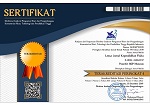Identifikasi Konsep-Konsep Sains dalam Proses Pembuatan Sopi Timor di Kabupaten Timor Tengah Selatan
Abstract
Sopi merupakan minuman tradisional masyarakat Timor yang harus dilestraikan. Sopi berbahan baku nira lontar (Borasus flabellifer. Tujuan penelitian ini untuk mengeksplorasi konsep-konsep sains dalam proses pembuatan sopi dan memetakan kompetensi dasar yang dapat dintegrasikan dengan proses pembuatan sopi. Metode penelitian yang digunakan adalah metode kualitatif pendekatan etnosains. Subjek penelitian adalah pembuat sopi Timor di desa Manufui kecamatan Santian kabupaten Timor Tengah Selatan yang berjumlah 3 orang pengrajin. Teknik pengumpulan data melalui observasi, wawancara mendalam, dan dokumentasi. Teknik analisis data yang digunakan analisis deskriptif untuk merekonstruksi proses pembuatan sopi ke konsep-konsep sains. Hasil explorasi konsep-konsep sains dalam proses pembuatan sopi adalah pengukuran, klasifikasi tumbuhan, mikroba dan laju pengembangbiakannya, perubahan fisika dan kimia, suhu, kalor, perpindahan kalor, perubahan fase dan pemisahan campuran. Implikasi hasil penelitian ini adalah potensi proses pembuatan sopi dapat digunakan sebagai sumber belajar yang perlu diteliti lebih lanjut pada masa mendatang.
Identification of Science Concepts in the Process of Making Sopi Timor in Timor Tengah Selatan District
Abstract
Sopi is a traditional Timorese drink that must be preserved. Sopi made from palm sap (Borasus flabellifer). The purpose of this research is to explore scientific concepts in the process of making sopi and to map basic competencies that can be integrated with the process of making sopi. The research method used is a qualitative method with an ethnoscience approach. in Manufui village, Santian sub-district, Timor Tengah Selatan district, totaling 3 craftsmen. Data collection techniques are through observation, in-depth interviews, and documentation. Data analysis techniques used are descriptive analysis to reconstruct the process of making sopi into scientific concepts. Results of exploration of concepts science in the process of making sopi is the measurement, classification of plants, microbes and their breeding rates, physical and chemical changes, temperature, heat, heat transfer, phase changes and mixture separation. The implication of this research is that the potential of the sopi-making process can be used as a source of bells. which need to be investigated further in the future.
Keywords
Full Text:
PDF (Bahasa Indonesia)References
Asbanu, D. E. S. I. U. (2017). The Development of Sound Wave Audacity Base Learning Media Using Ethnoscience Approach of Amanuban Tribe to Improve Physics Teacher Candidates? Science Process Skill. International Journal of Science and Research (IJSR), 6(11), 324–329. https://doi.org/10.21275/28101702
Atmojo, S. E., Kurniawati, W., & Muhtarom, T. (2019). Science Learning Integrated Ethnoscience to Increase Scientific Literacy and Scientific Character. Journal of Physics: Conference Series, 1254(1). https://doi.org/10.1088/1742-6596/1254/1/012033
BanoEt, R. I. M., Sudana, I. M., & Wirya, I. G. N. A. S. (2016). Manfaat Beberapa Jenis Mikroba Yang Diisolasi Dari Kayu Laru (Peltophorum pterocarpum) dan Mur Sebagai Starter dalam Pembuatan Laru dan Sopi di Pulau Timor. Agric. Sci. and Biotechnol, 5(1), 39–48.
Basuki, F. R., Jufrida, & Suryanti, K. (2019). Identification of potential local wisdom of senamat ulu village (electrical independent village) as a source of science learning. Journal of Physics: Conference Series, 1185(1). https://doi.org/10.1088/1742-6596/1185/1/012102
Gunawan, Y. Y., Sarwanto, & Nurosyid, F. (2019). The analysis of students’ critical thinking skill through ethnoscience instruction integrated on the topic of magnetic field. AIP Conference Proceedings, 2194(December). https://doi.org/10.1063/1.5139765
Han, E. S., Goleman, D., Boyatzis, R., & Mckee, A. (2019). Effects of Ethnoscience and Traditional Laboratory Practical on Science Process Skills Acquisition ofSecondary School Biology Students in Nigeria. Journal of Chemical Information and Modeling, 53(9), 1689–1699.
Husna, M., & Kuswanto, H. (2018). Development of physics mobile learning based on local wisdom to improve vector and diagram representation abilities. International Journal of Interactive Mobile Technologies, 12(6), 85–100. https://doi.org/10.3991/ijim.v12i6.8746
Kurti, N., & This-Benckhard, H. (1994). Chemistry and physics in the kitchen. Scientific American, 270(4), 66–71. https://doi.org/10.1038/scientificamerican0494-66
Lestari, N., & Fitrian, F. (2016). Physics education based ethnoscience: Literature Review. Physics Education Based Ethnoscience: Literature Review, 2016(Icmse), 31–34. https://journal.unnes.ac.id/sju/index.php/icmse/article/view/13371/7401
Ma’rit. (2018). Eksistensi Para Pembuat Sopi di Kecamatan Sambi Rampas Kabupaten Manggarai Timur. Skripsi. Program Studi Pendididkan Sosiologi, Fakultas Keguruan Dan Ilmu Pendidikan, Universitas Muhammadiyah Makasar, September, 1–106.
Nadhifatuzzahro, D. N. (2014). Abstrak. 225–234.
Naiola, E. (2008). Amylolitic microbes of nira and laru from Timor Island, East Nusa Tenggara. Biodiversitas Journal of Biological Diversity, 9(3), 165–168. https://doi.org/10.13057/biodiv/d090302
Puspasari, A., Susilowati, I., Kurniawati, L., Utami, R. R., Gunawan, I., & Sayekti, I. C. (2019). Implementasi Etnosains dalam Pembelajaran IPA di SD Muhammadiyah Alam Surya Mentari Surakarta. SEJ (Science Education Journal), 3(1), 25–31. https://doi.org/10.21070/sej.v3i1.2426
Rowat, A. C., Sinha, N. N., Sorensen, P. M., Campàs, O., Castells, P., Rosenberg, D., Brenner, M. P., & Weitz, D. A. (2014). The kitchen as a physics classroom. Physics Education, 49(5), 512–522. https://doi.org/10.1088/0031-9120/49/5/512
Satriawan, M., & Rosmiati. (2016). Pengembangan Bahan Ajar Fisika Berbasis Kontekstual dengan Mengintegrasikan Kearifan Lokal untuk. Jurnal Penelitian Pendidikan Sains, 6(1).
Suastra, I. W., Jatmiko, B., Ristiati, N. P., & Yasmini, L. P. B. (2017). Developing characters based on local wisdom of bali in teaching physics in senior high school. Jurnal Pendidikan IPA Indonesia, 6(2), 306–312. https://doi.org/10.15294/jpii.v6i2.10681
Sudarmin, & Sumarni, W. (2018). Increasing character value and conservation behavior through integrated ethnoscience chemistry in chemistry learning: A Case Study in the Department of Science Universitas Negeri Semarang. IOP Conference Series: Materials Science and Engineering, 349(1), 0–8. https://doi.org/10.1088/1757-899X/349/1/012061
Sukma, T. A., Mundilarto, M., & Putri, N. D. (2019). Local wisdom-Based Electronic Book on Newton’s Law. Jurnal Ilmiah Pendidikan Fisika Al-Biruni, 8(2), 197–209. https://doi.org/10.24042/jipfalbiruni.v0i0.4368
Sumarni, W., Sudarmin, Wiyanto, & Supartono. (2016). The reconstruction of society indigenous science into scientific knowledge in the production process of palm sugar. Journal of Turkish Science Education, 13(4), 281–292. https://doi.org/10.12973/tused.10185a
Wati, E., Yuberti, Saregar, A., Fasa, M. I., & Aziz, A. (2021). Literature Research: Ethnoscience in Science Learning. IOP Conference Series: Earth and Environmental Science, 1796(1), 2007–2016. https://doi.org/10.1088/1742-6596/1796/1/012087
DOI: https://doi.org/10.33394/j-lkf.v9i2.4396
Refbacks
- There are currently no refbacks.

This work is licensed under a Creative Commons Attribution-ShareAlike 4.0 International License.

Lensa: Jurnal Kependidikan Fisika is licensed under a Creative Commons Attribution-ShareAlike 4.0 International License.


.png)